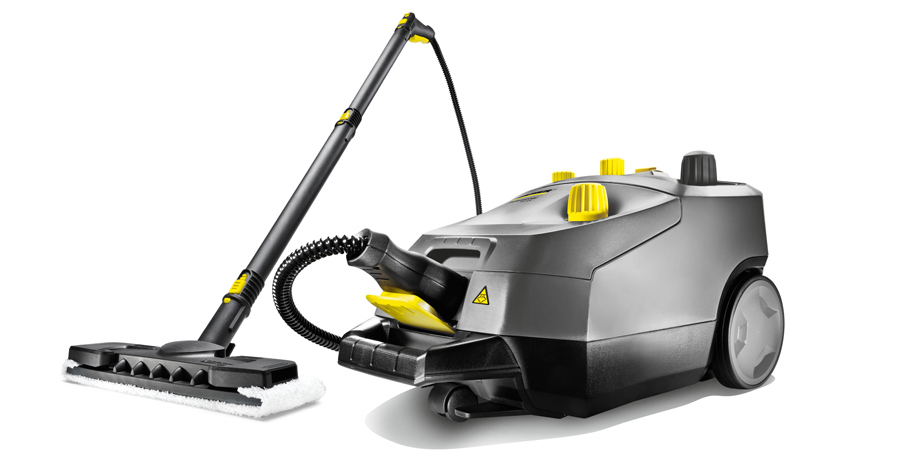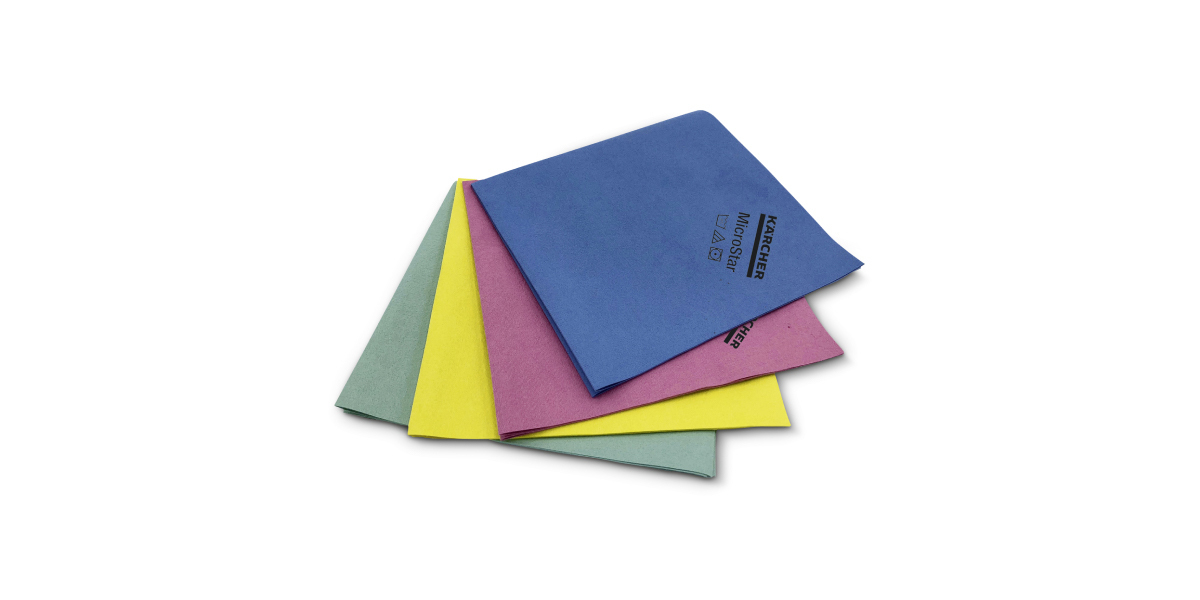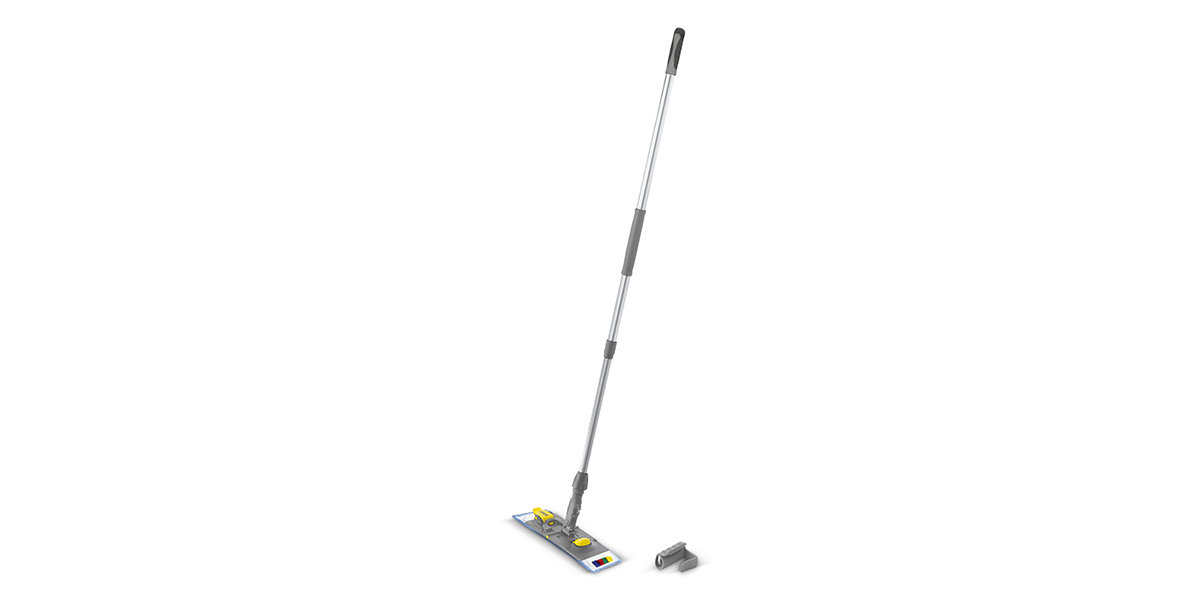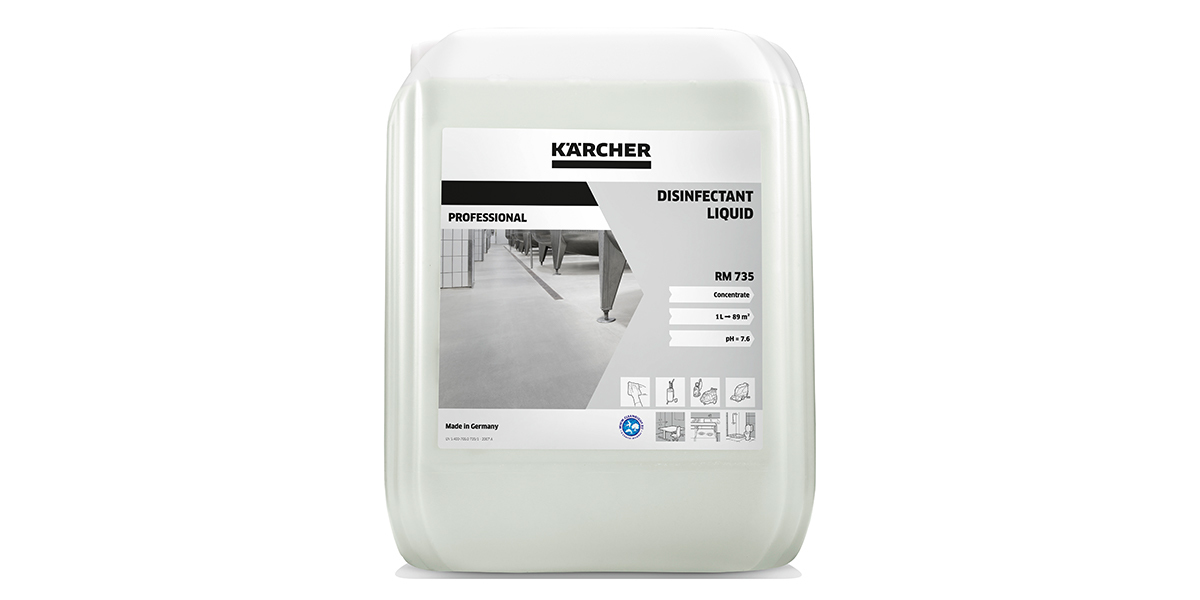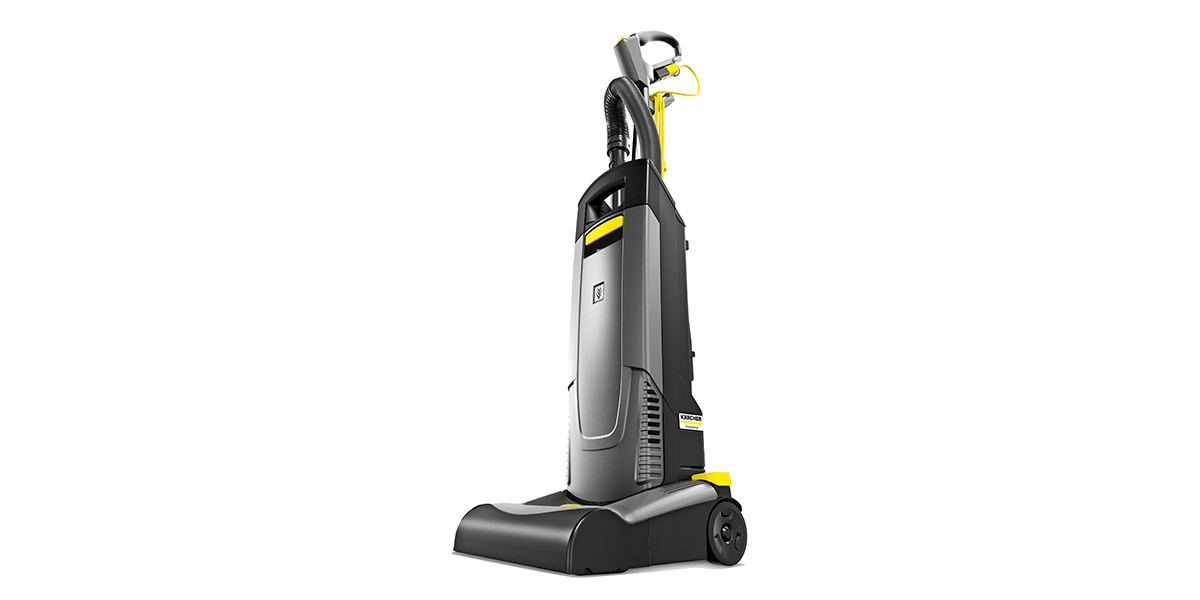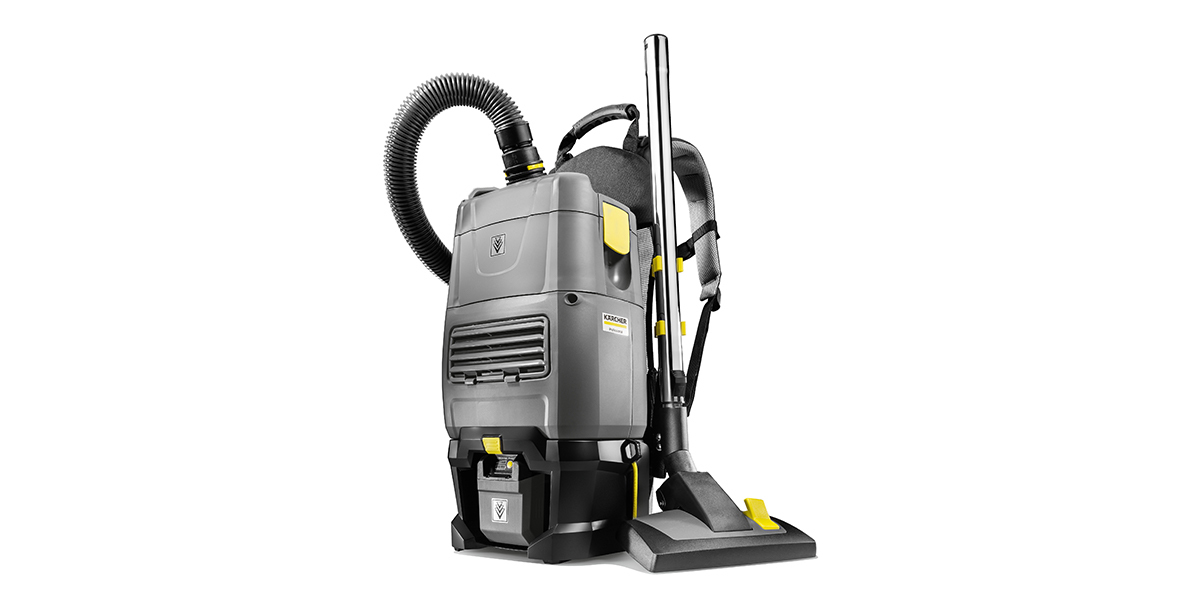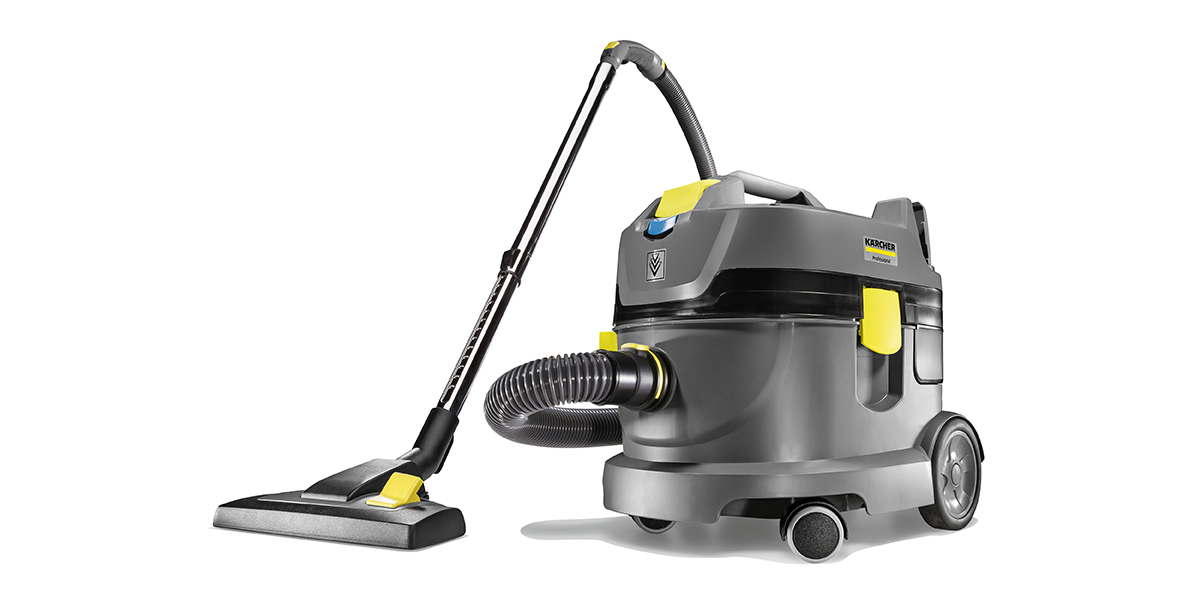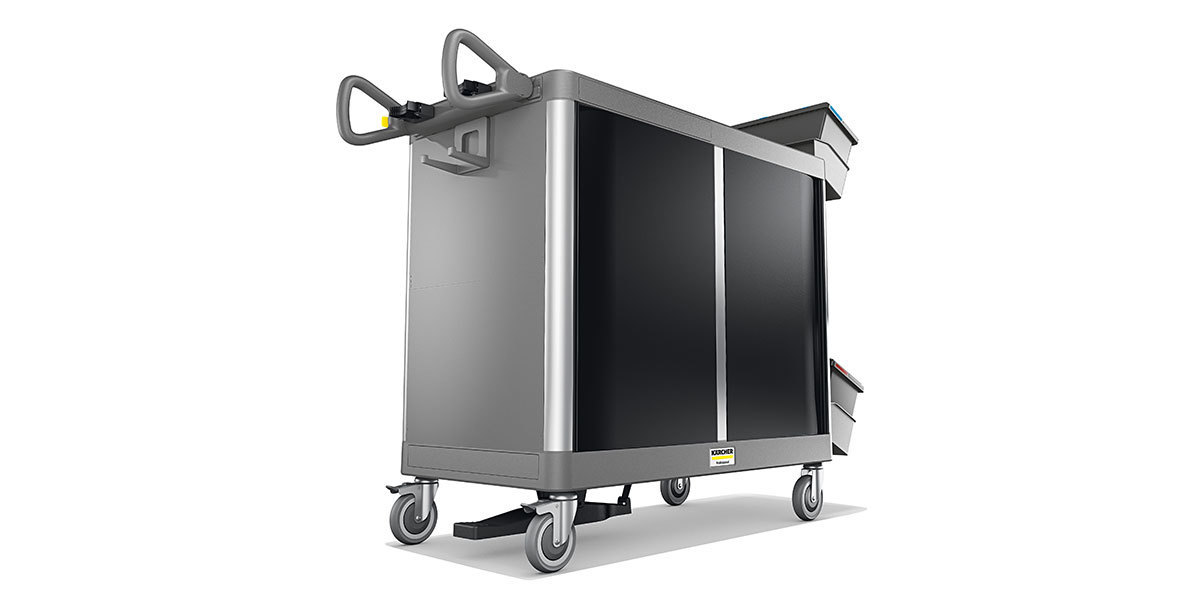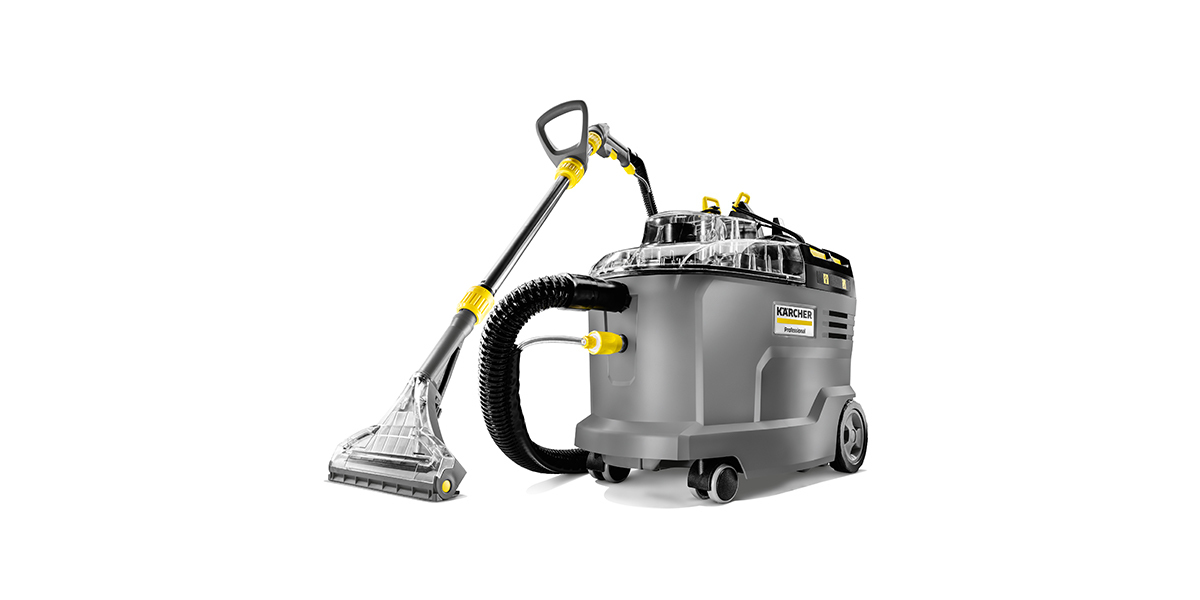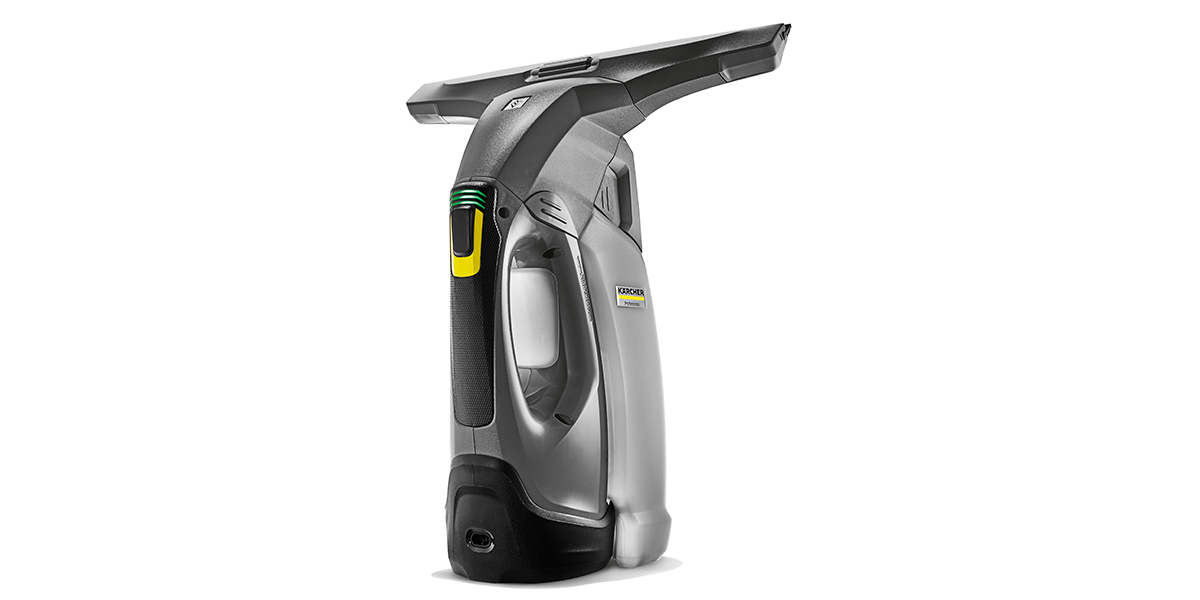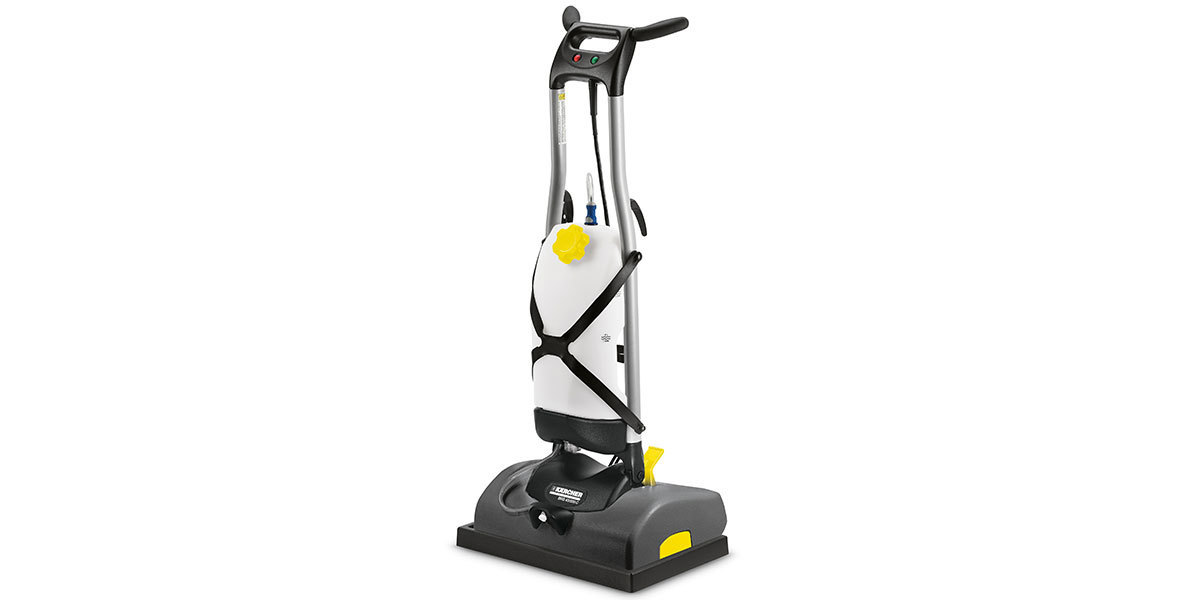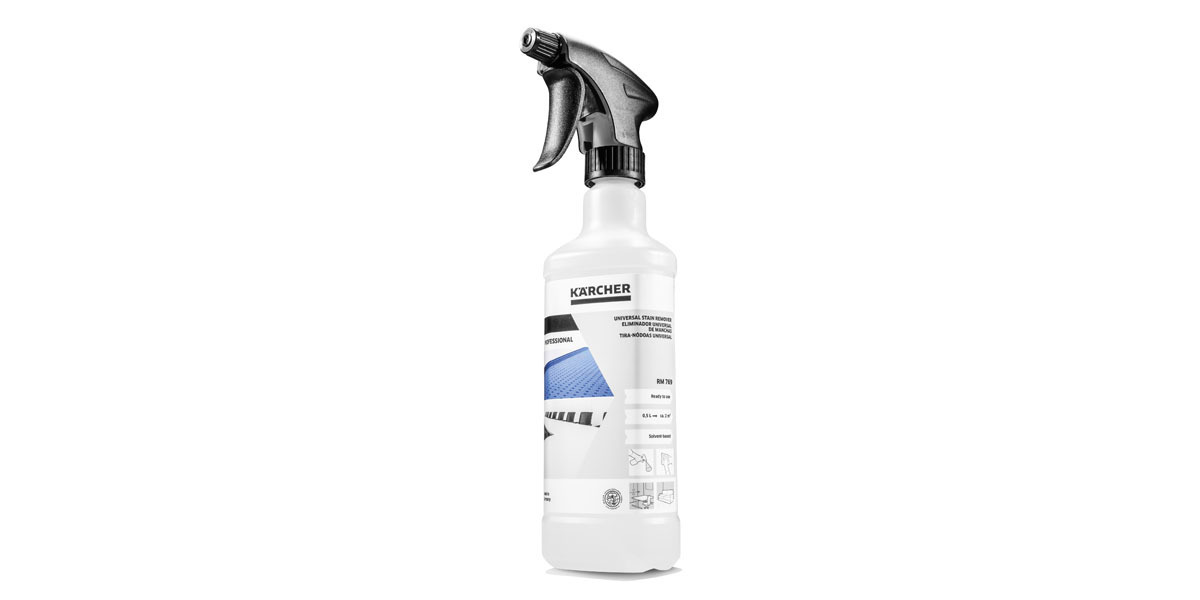Hotel room cleaning
Whether it’s business travelers or families on holiday, a clean hotel room is a must for a successful stay. Guests don't want to see stained carpets and dirty sinks. Once negative impressions have been made it’s difficult to change bad ratings. Feel-good rooms ensure satisfaction with guests and good ratings. For a hygienic hotel room optimal cleaning management is essential. Here’s an overview of how to clean a hotel room for an impeccable result.
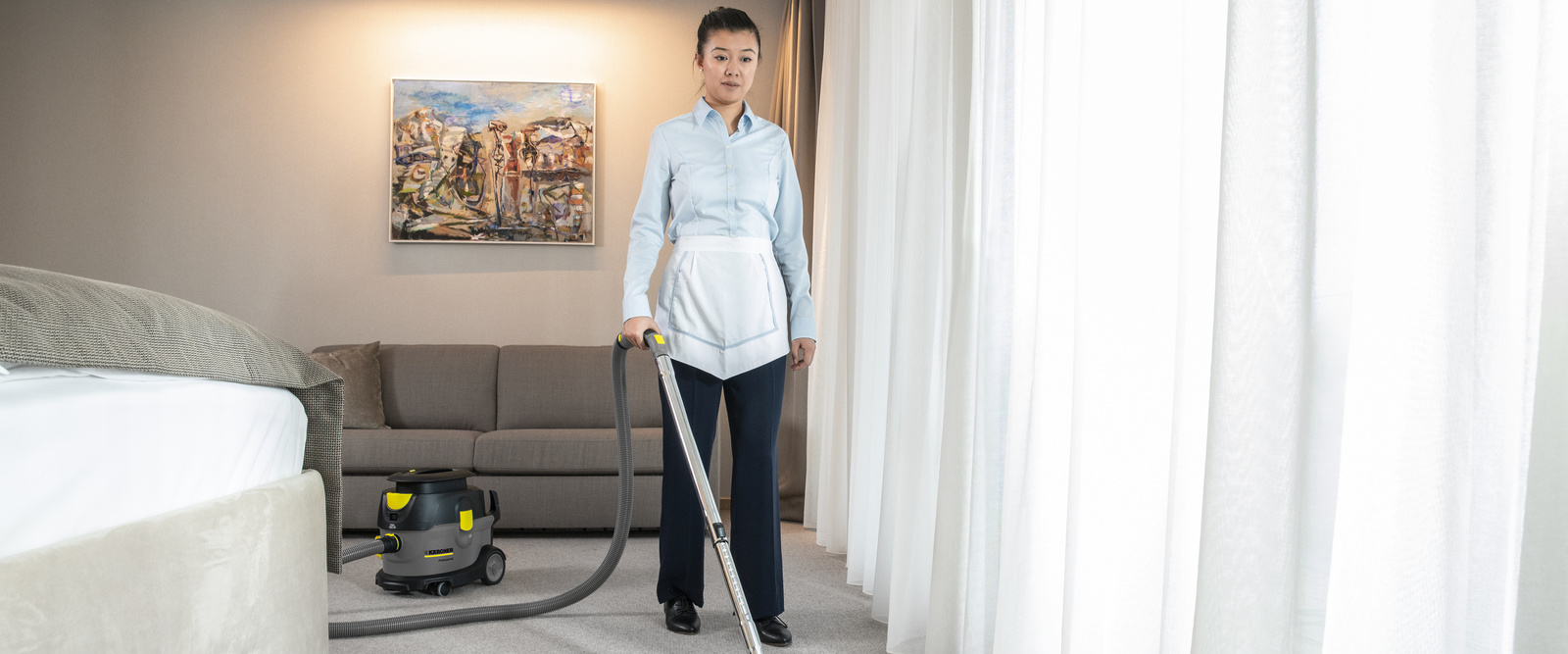

When a guest books a hotel room, it’s a sign of trust. Trust that hygiene standards will be meticulously maintained, and that the guests' well-being will come first. When cleaning a hotel room, a thorough checklists and guidelines are extremely helpful. Equally indispensable is suitable cleaning equipment that’s been adapted to the local conditions and the materials used in the rooms. Ongoing training also helps to ensure efficient processes and consistent quality.
Hotel room cleaning: a convincing result step by step
First, a distinction must be made between cleaning during a guest's stay and the more detailed steps involved when a guest checks out. It goes without saying that beds have to be freshly made every time you welcome a new guest, apart from this, it’s of course important to adapt the intensity of the individual cleaning steps to the occasion. More elaborate cleaning steps, such as the deep cleaning of carpets with a spray extraction cleaner, are carried out less frequently, for example at the end of the season. In principle, regular cleaning in hotel rooms should follow an established routine: cleaning is done from dirty to clean and from top to bottom. In addition, one should move from dry to wet methods.
In general, cleaning a hotel room can be divided into the following steps:
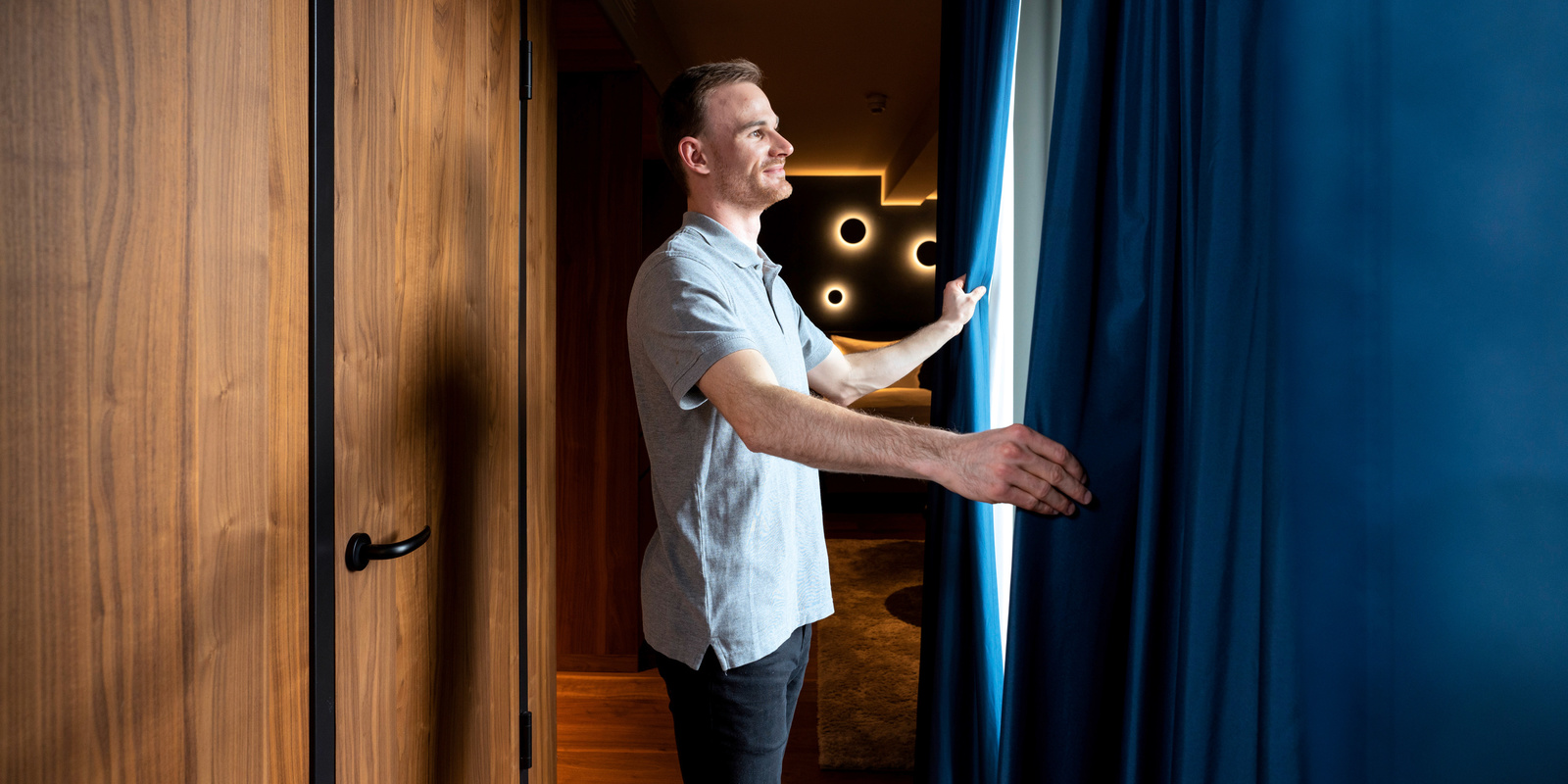
1. Airing out
The first thing to do is to open the windows or check the setting of the air conditioner. While cleaning in the hotel room, the air conditioner may be adjusted. When finished it should be reset to the correct setting.

2. Disposing of
Used items such as dirty towels and bedding, if applicable, should be removed. Likewise, any rubbish should be disposed of.
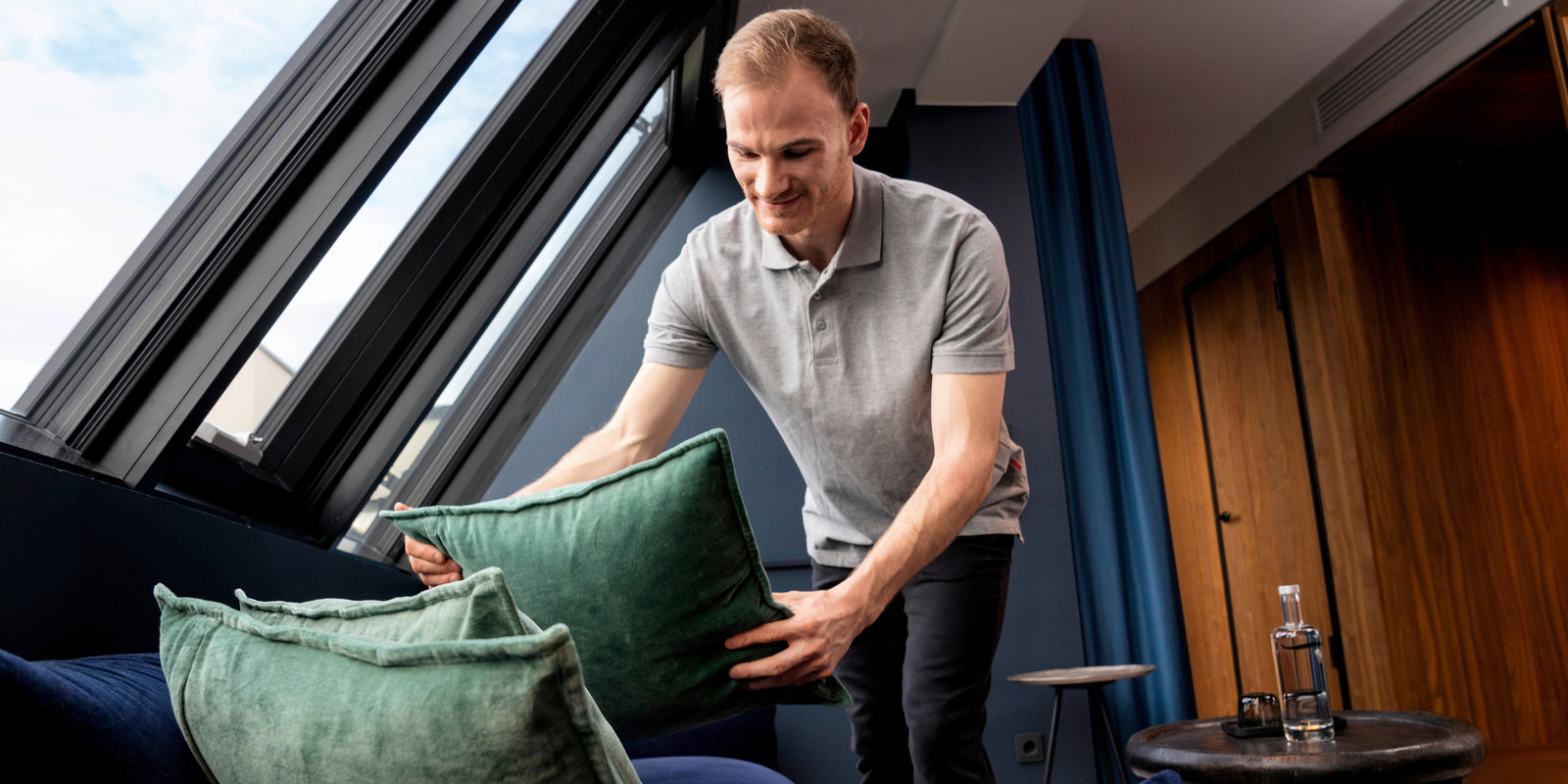
3. Tidying up
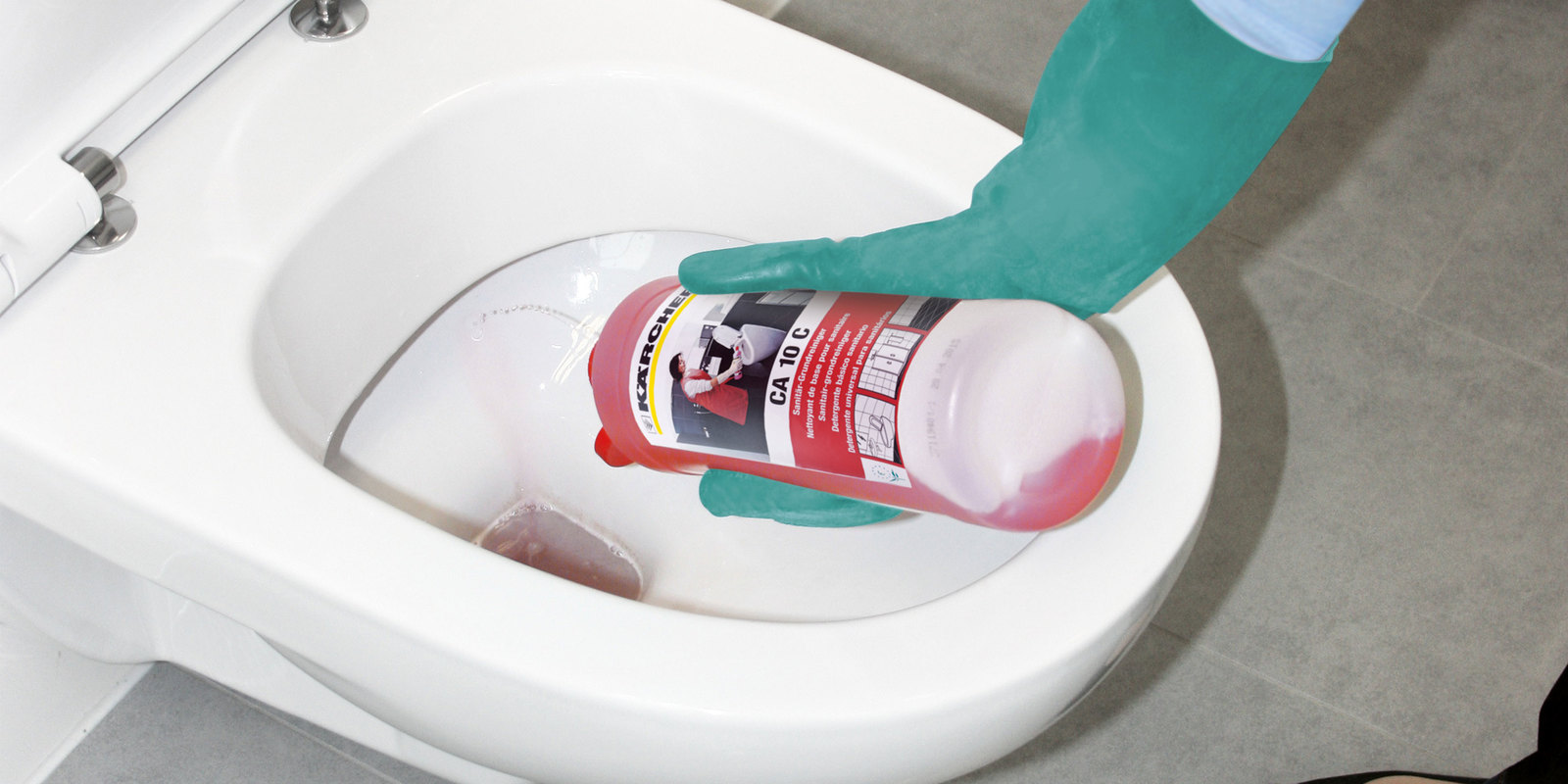
4. Applying cleaning agents
Hotel room cleaning starts in the bathroom. The first step is to apply the cleaning agents, then they are left to act, for example, foam cleaner in the toilet or on the shower walls. While they are working their magic, other areas of the hotel room can be cleaned.
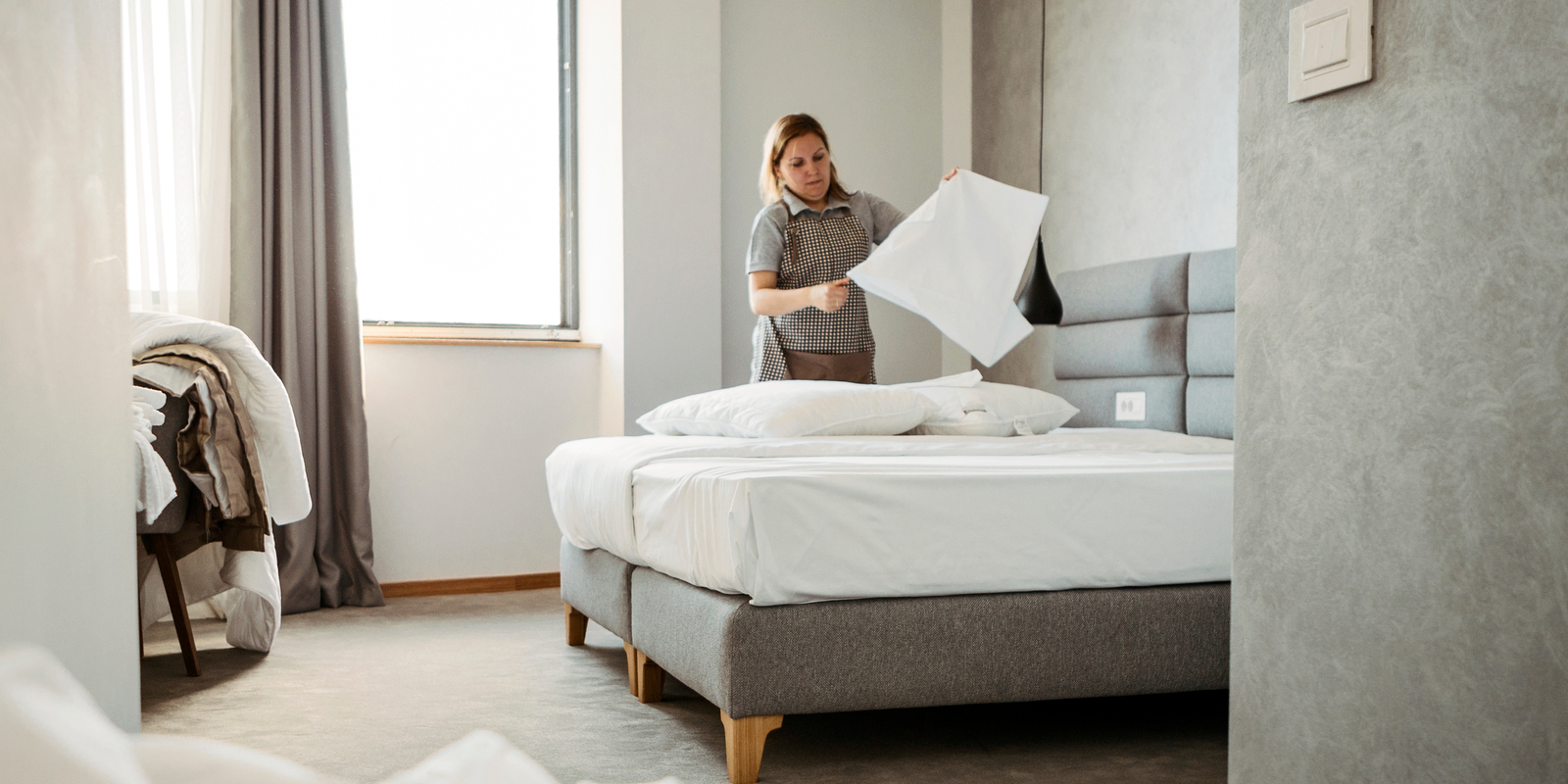
5. Making the beds
Hotel beds should always be freshly made.
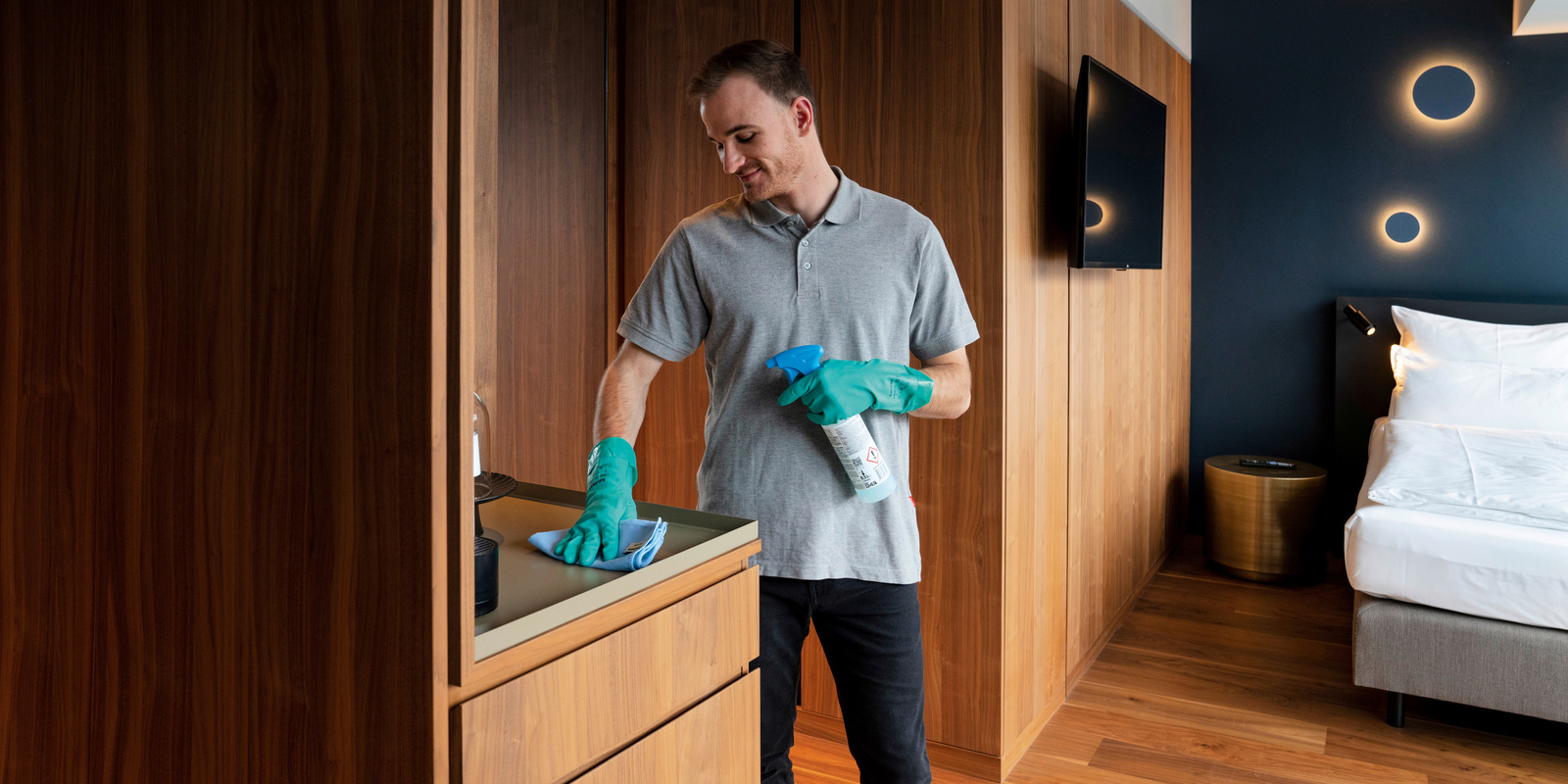
6. Surface cleaning
Most of the time surfaces are cleaned manually with the help of some cleaning tools. A dry dust-binding cloth is ideal to trap loose dirt. Alternatively, for damp surface cleaning microfibre cloths can be used in conjunction with spray-on cleaning agents. Pre-soaked microfibre cloths are another option. These are soaked in the correct amount of cleaning solution before cleaning and placed in a bucket. To ensure that the hotel room is cleaned thoroughly, hard-to-reach and hidden areas must also be taken into account when cleaning surfaces.
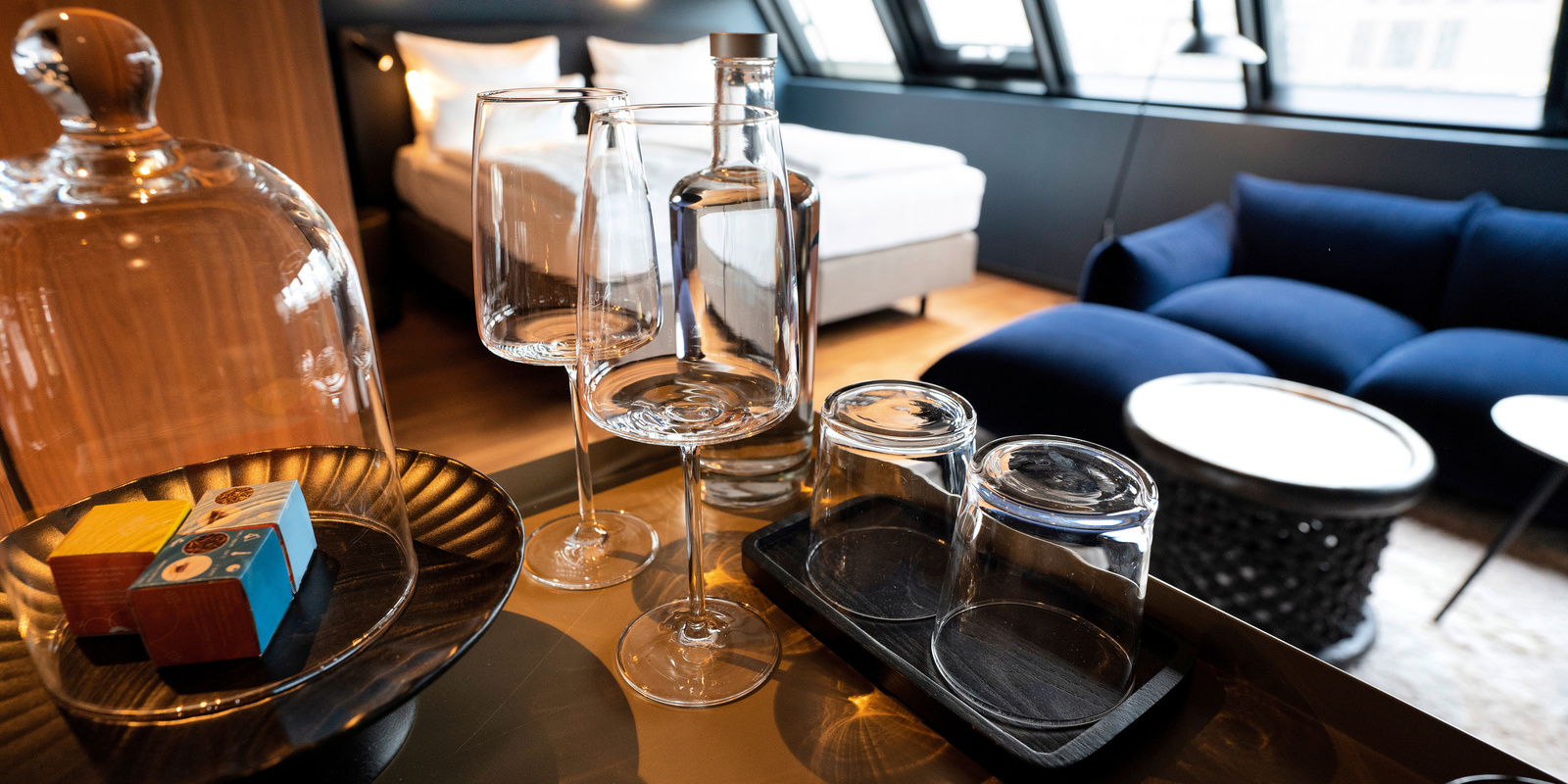
7. Restocking
After cleaning all the surfaces, the hotel room is restocked, this includes the minibar, the dishes, etc.
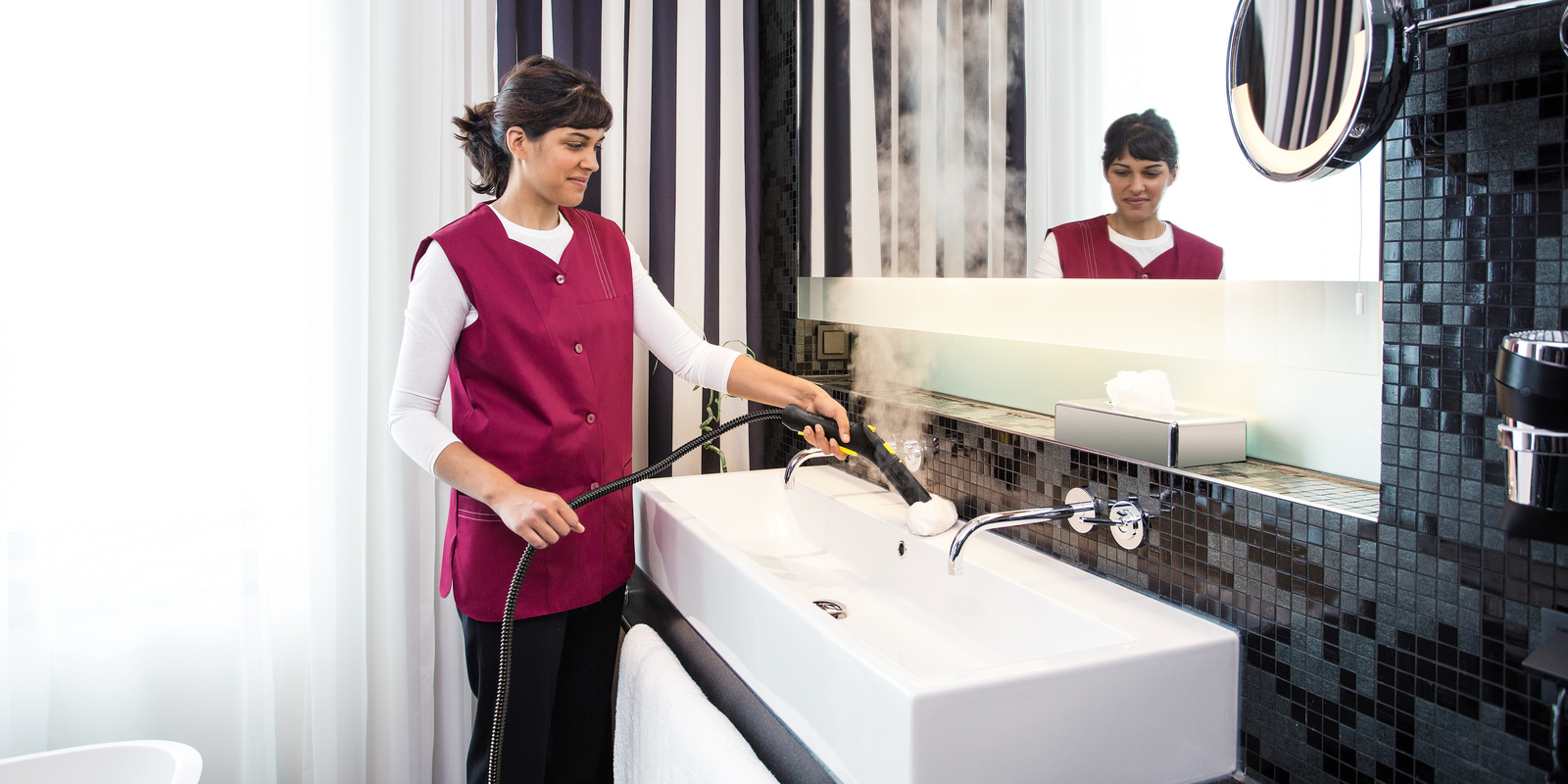
8. Bathroom cleaning in the hotel room
Bathroom cleaning in the hotel room includes cleaning of all surfaces, including toilet, shower stall, or tub, sink, etc. Usually, manual cleaning equipment is used, but steam cleaners can also be an efficient choice. Steam penetrates even hard-to-reach and has a germ-reducing effect. Another helpful tool is the window and surface vacuum cleaner. It can be used to conveniently clean glass surfaces and tiles without leaving streaks, as the water is sucked up.
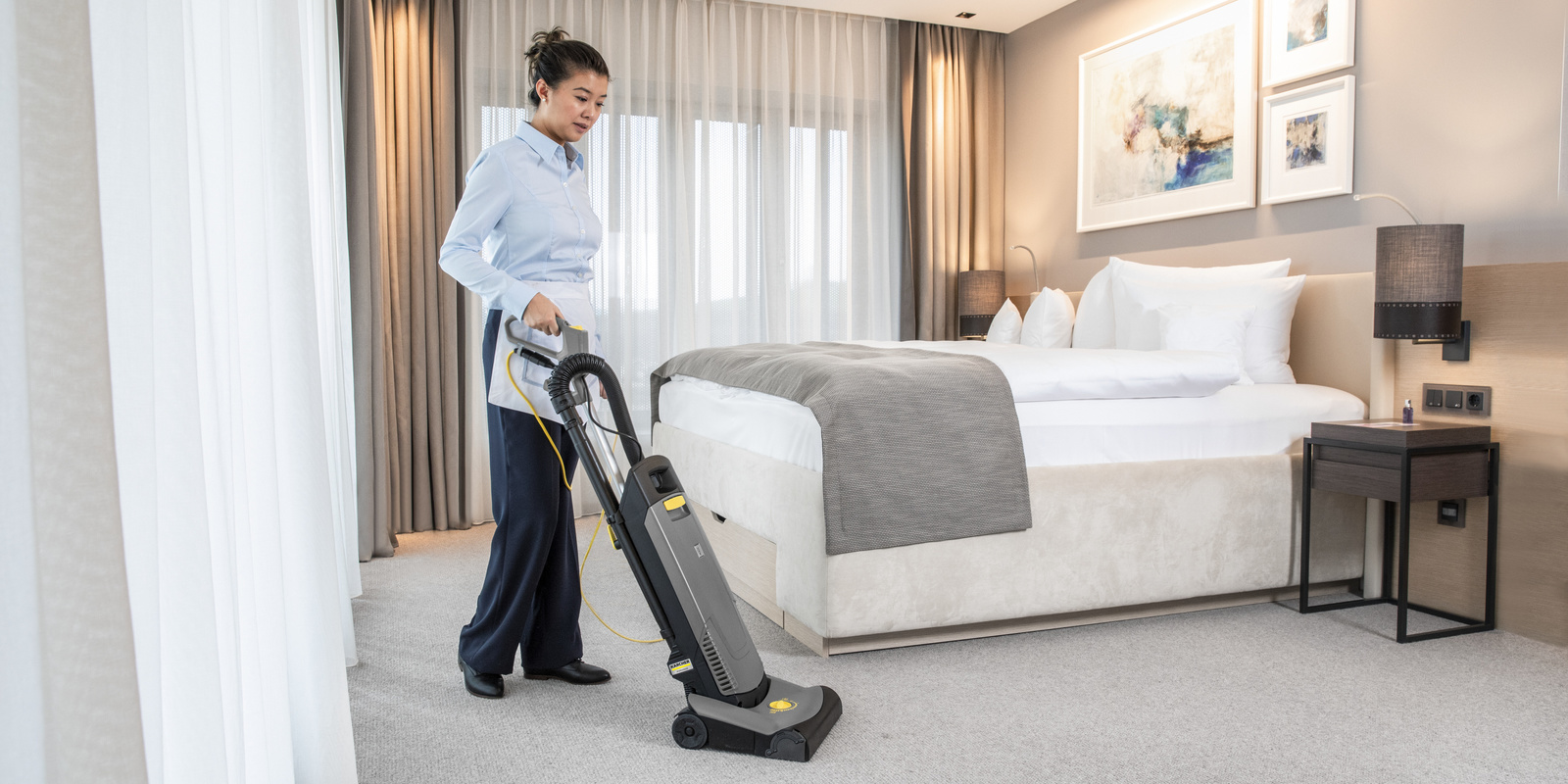
9. Vacuuming
After cleaning the bathroom in the hotel room vacuuming the floors should follow. Here, the selection of a suitable vacuum cleaner depends on the floor type. Hard floors can be cleaned with a wet/dry vacuum cleaner, carpeted floors with a carpet vacuum sweeper. The combination of suction and brush removes particularly stubborn dirt from the fibres. Using a carpet vacuum sweeper is the most thorough method when cleaning textile coverings.
Important when vacuuming: hard-to-reach places, such as under the bed, must not be forgotten.
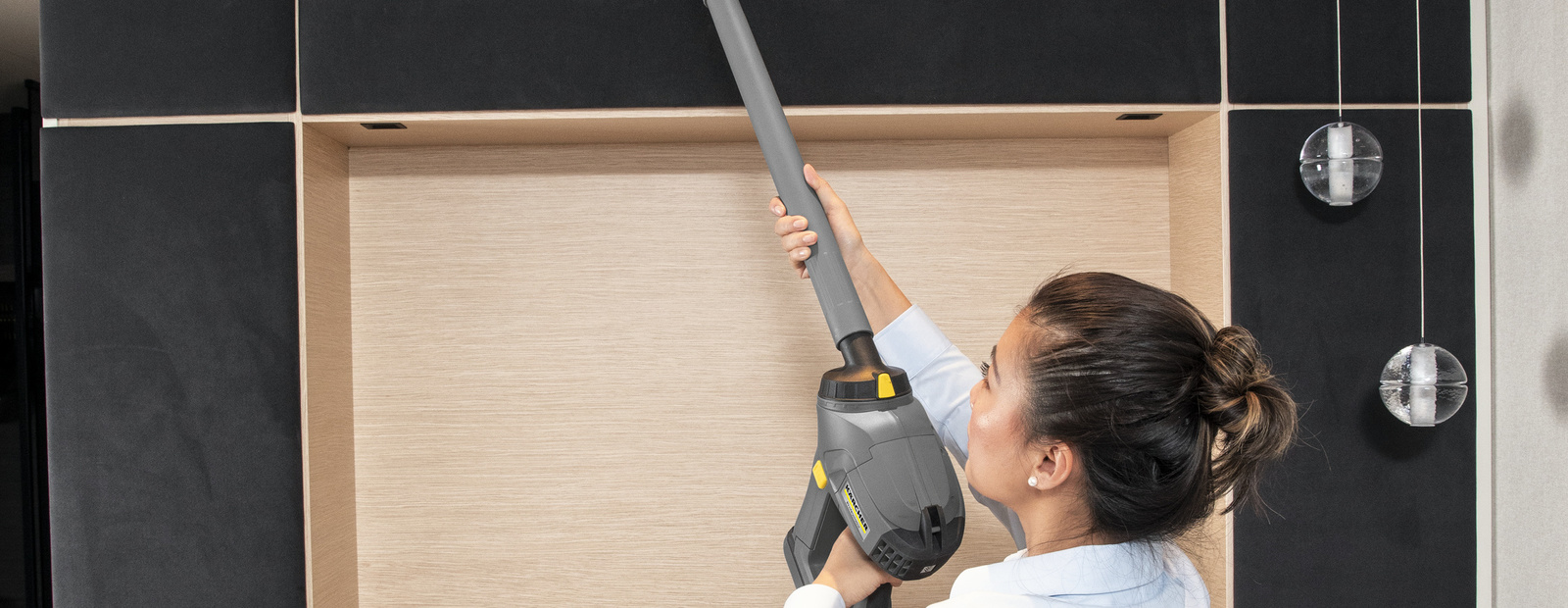
There are suitable accessories for overhead cleaning of cabinets and mouldings on the ceilings, such as angled telescopic poles or extension sets. Such accessories are also appropriate in terms of work safety when cleaning rooms in hotels, as users don’t have to use a ladder to reach the relevant areas.
Thorough window cleaning does not have to be carried out on a daily basis. Only marks such as fingerprints or stains are removed as part of the surface cleaning routine.
Hygienic colour theory: 4 colours for efficient and safe hotel room cleaning.
For safe and hygienic hotel room cleaning and to prevent the spread of germs, there’s a colour system for different areas. The 4 easily distinguishable colours red, green, blue and yellow are used. Each colour represents an area. This prevents a cloth that was used to clean a toilet, from being used to clean a kitchen counter. Cleaning utensils such as buckets and cloths are available in the colours recommended, but cleaning agents can also be based on this colour scheme.
In the bathroom:
- Red: is used for the toilet, the urinal and the tiles in their immediate vicinity.
- Yellow: is used to clean sinks, tiles, shelves, faucets, mirrors, shower stalls and tubs in the bathroom.
Outside the sanitary area:
- Blue: is used for cleaning furniture, for example, chairs, tables, shelves and doors.
- Green: is for cleaning the kitchen area.
Practical tips:
- Battery-powered vacuums make it easier to work because you don't have to move the cord and there are no tripping hazards either. Battery-powered backpack vacuums have the additional advantage that they do not get caught on furnishings.
- The mattress of a freshly made hotel bed, should be vacuumed with the appropriate accessories. It’s also recommended to turn the mattress every few months. If there are stains on the mattress, they can be removed with suitable cleaning agents, whereby it’s essential to follow the instructions of the mattress manufacturer.
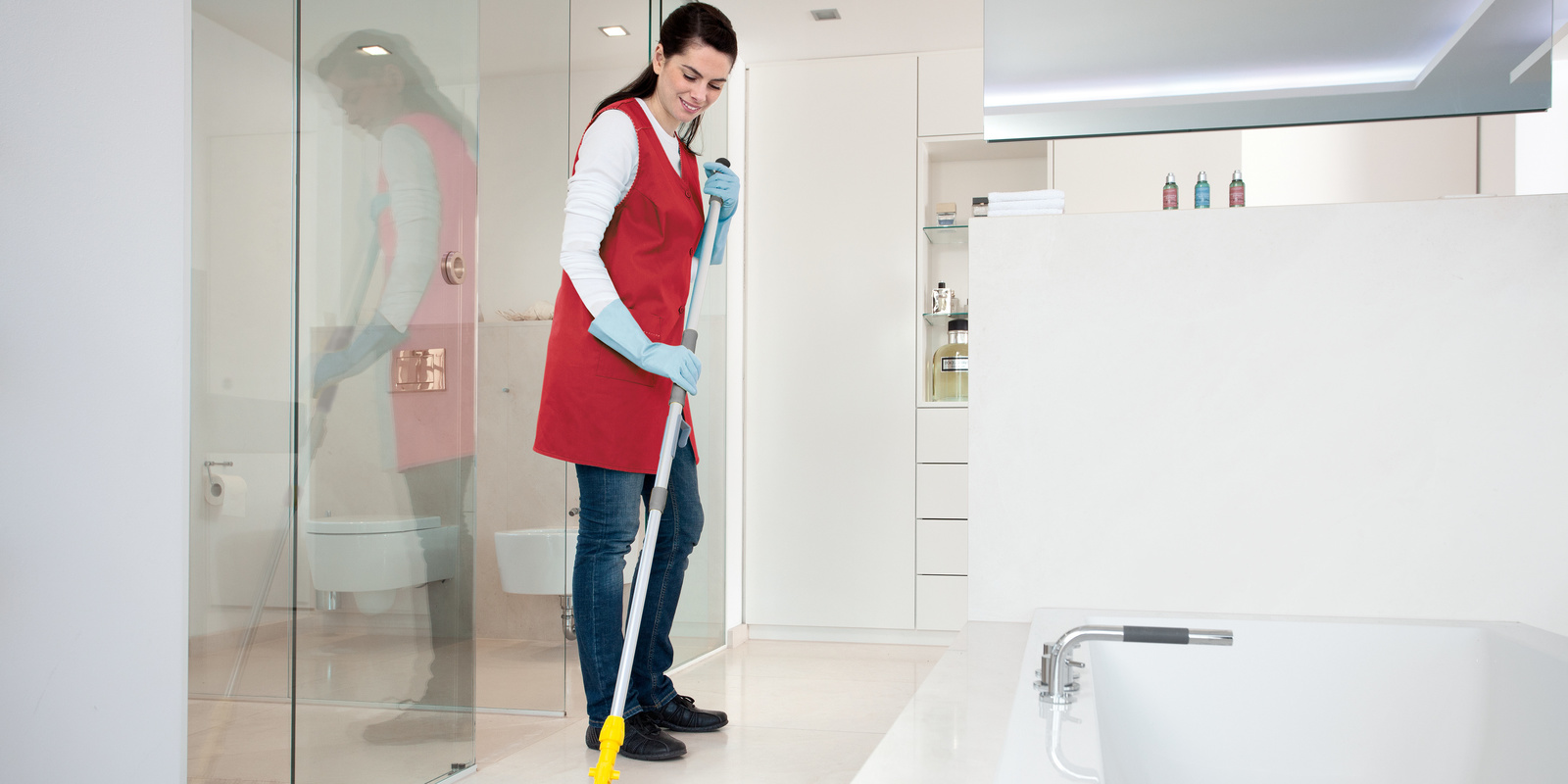
10. Cleaning the floor
Hard floors in small rooms are usually cleaned with a mop.
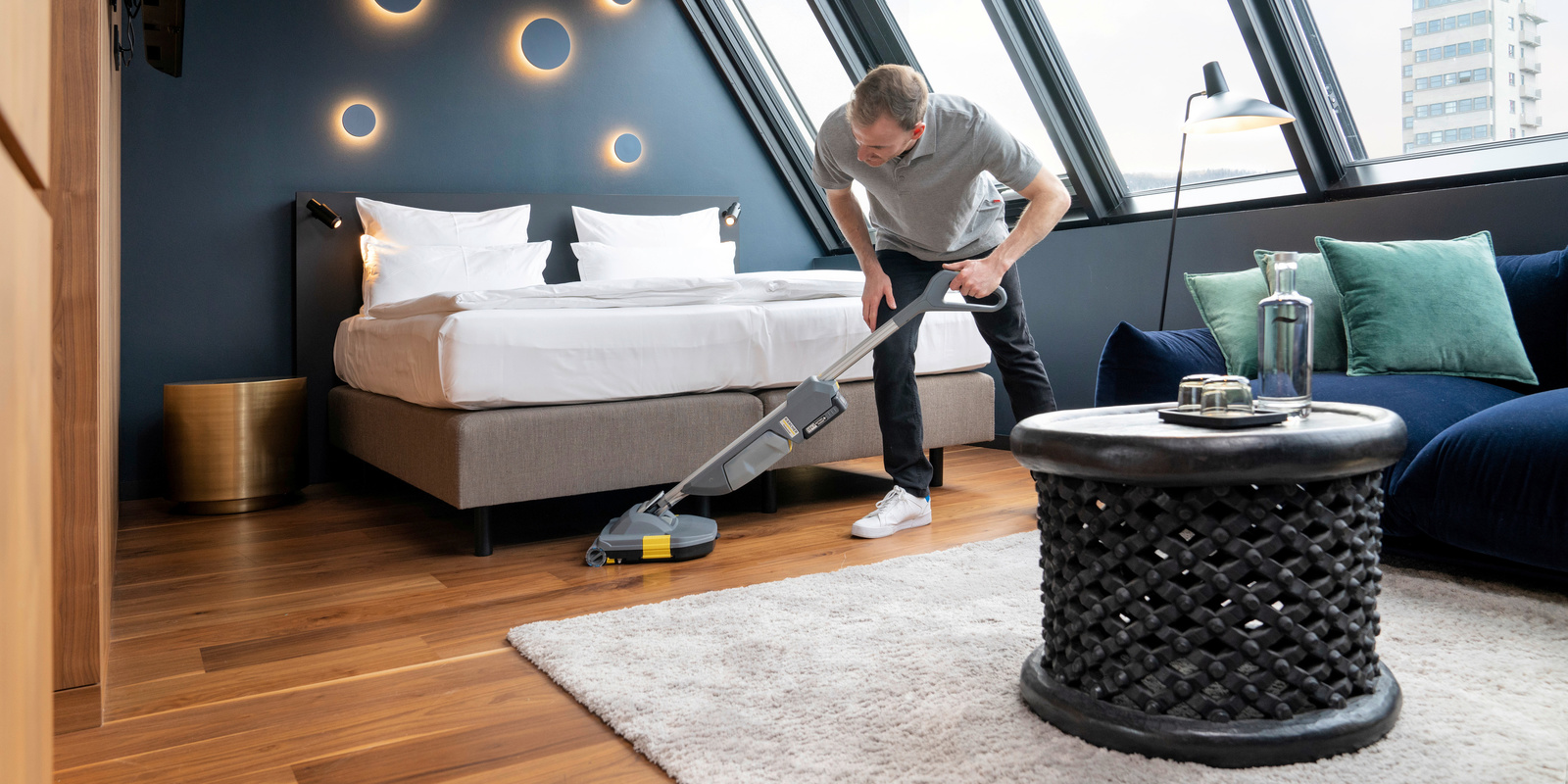
However, there are also very small and maneuverable scrubber dryers which is ideal for small areas and ensure hygienic cleanliness. An important advantage: users do not come into contact with the dirty water. In addition, fresh water is used for cleaning, as the dirty water is immediately sucked up. Because of this, the floor is immediately dry again.
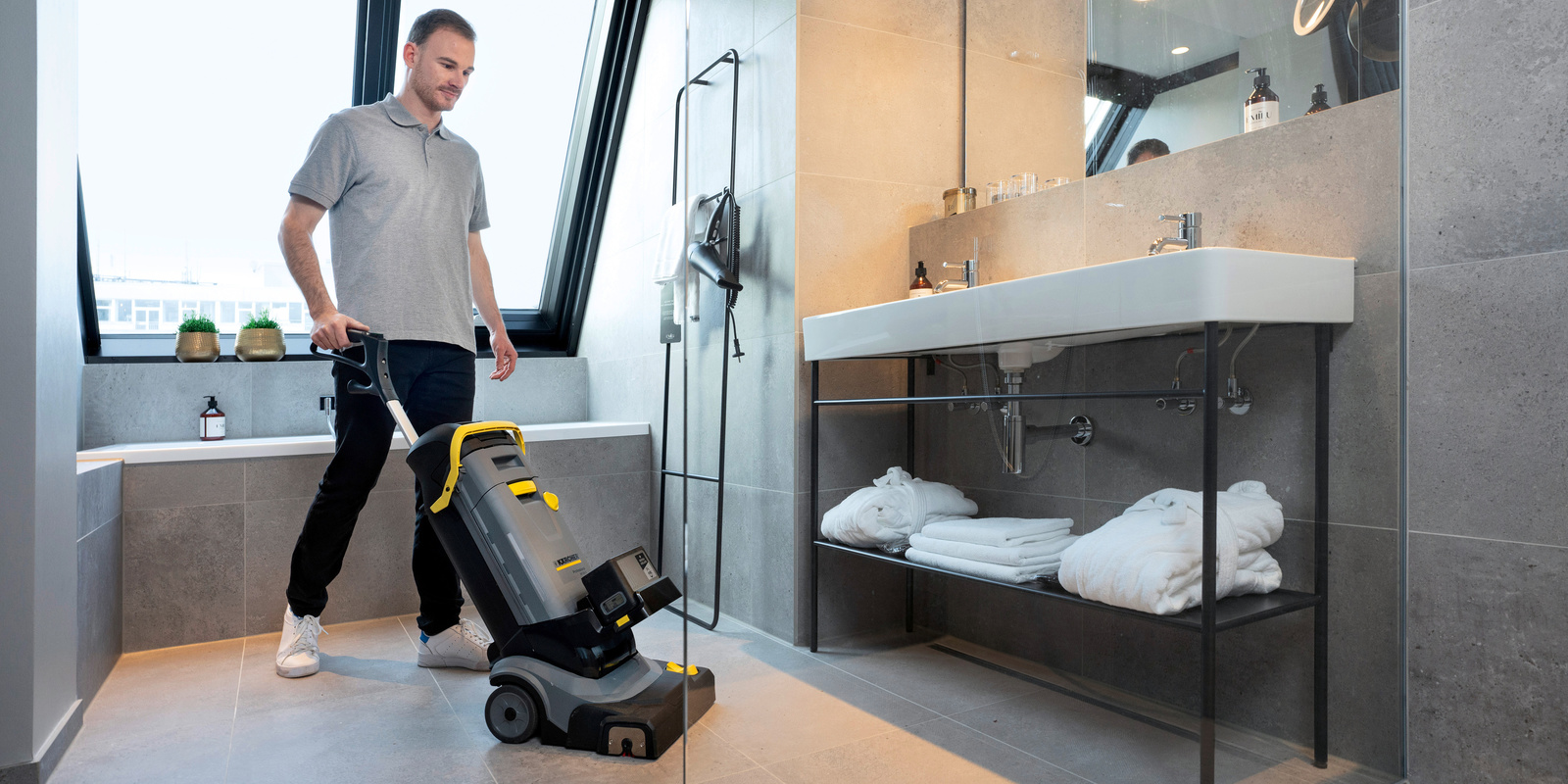
Similar to vacuum cleaners, battery-powered scrubber dryers are also available, which eliminates tripping hazards and makes them easier to use. When wet-cleaning flooring, it’s recommended to tackle the floor of the main room first and then the bathroom floor.
11. Visual inspection
The visual inspection is an important step when cleaning a hotel room. Certain things are checked during the inspection, such as whether all furnishings, for example the television, are functional. If further work is required, the relevant information is passed on to the central office. If a fresh stain on the carpet or on upholstery is discovered, it can be removed immediately. There are many reasons for prompt removal: fresh stains are easier to remove, and the cause of an old stain is often more difficult to identify. If the stain cannot be removed or if the spot is too large, additional cleaning equipment is needed that may not be available in the day-to-day cleaning kit, such as a spray extraction cleaner with a small hand nozzle.

Tip – good to know:
90 % of all stains are water soluble. Common types of stains encountered when cleaning a hotel room include coffee, tea, red wine, cola, fruit juices, shoe polish and nail polish.
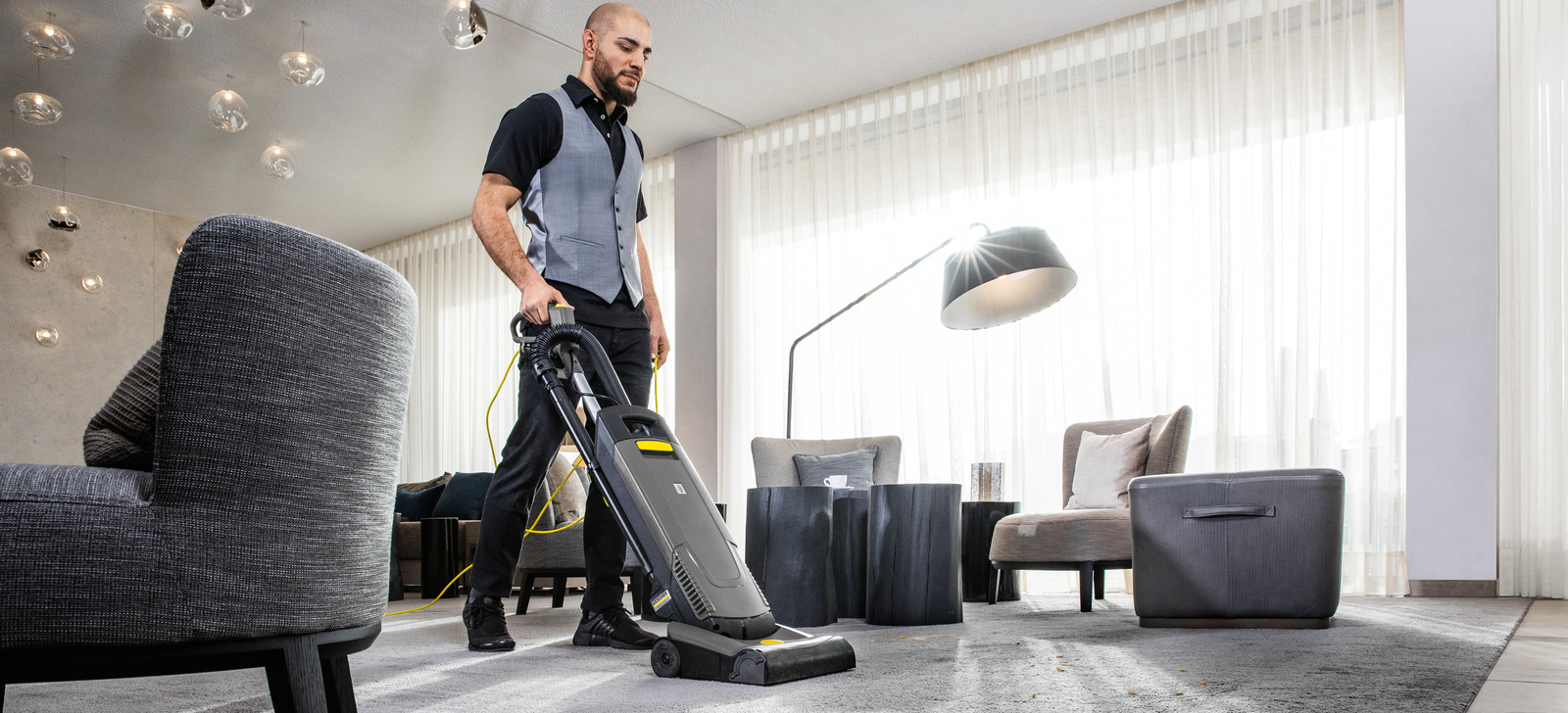
Carpet cleaning
A carpet feels warm, dampens noise and creates a feel-good atmosphere. Depending on the material and quality, textile floor coverings can be sensitive to moisture, and the removal of stains, which is not a problem with other coverings. This can quickly lead to an unkempt appearance. Cleaning carpet requires some expertise, as the structure of the textile covering, as well as the cleaning characteristics of the individual components should be known in advance. Here’s what to consider when cleaning carpets and how to quickly remove stains.
EXCURSUS: Carpet cleaning in hotel room

The foundation for a good impression: clean carpets
To maintain a carpet for as long as possible, a more thorough cleaning, beyond just stain removal, is necessary from time to time. To delay time-consuming basic cleaning of a hotel room - and the associated costs, disproportionate use of resources and possible loss of revenue – it’s recommended that interim cleaning be performed on a regular basis. During interim cleaning, small areas of carpet can be treated with a spray extraction device. For continuously laid carpet, the use of a small carpet cleaning machine is recommended. This not only reliably removes the dirt in the upper half of the carpet fibres, but also refreshes the carpet at the same time.
An important advantage of the method: depending on the material and the degree of soiling, the carpet is already dry and walkable again after 20 to 40 minutes; the room can therefore remain on sale.
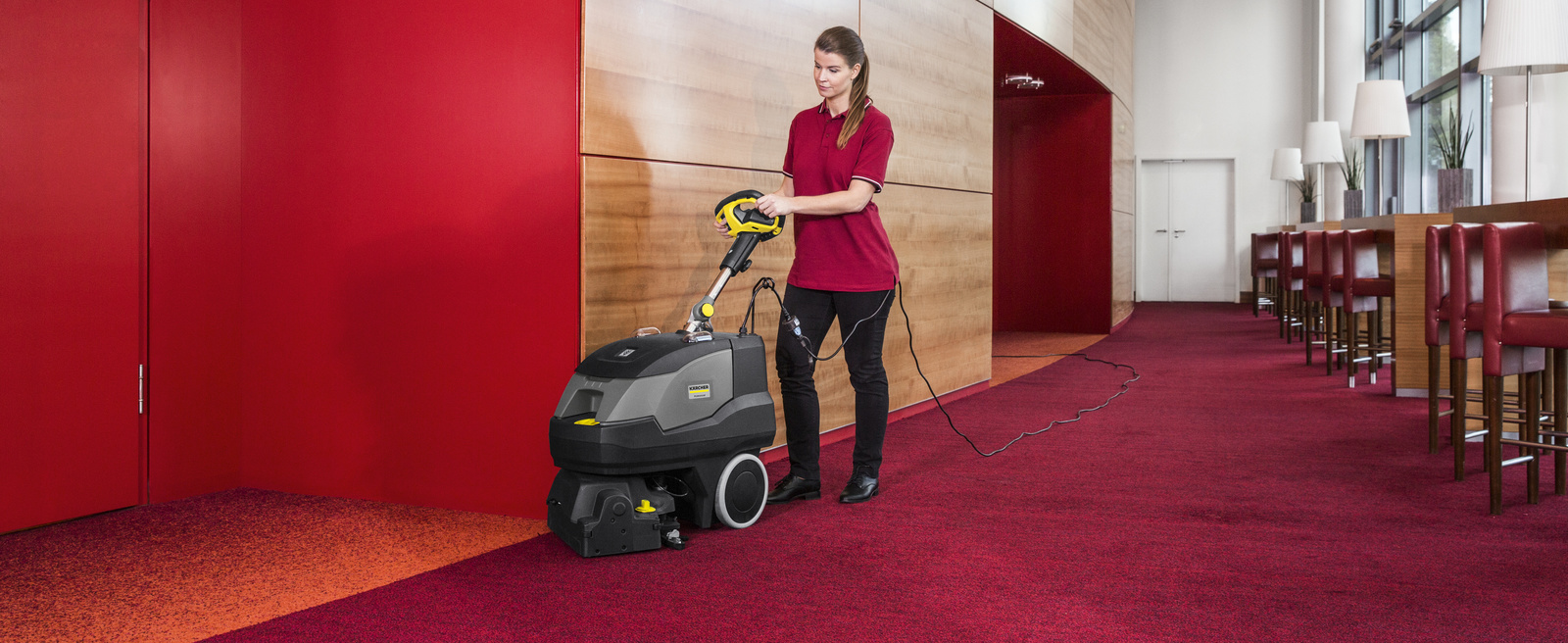
Intermediate carpet cleaning
As beautiful, pleasant underfoot, and noise-absorbing as carpets may be, wear and tear are likely as trails and traces of dirt form bit by bit and can no longer be simply removed by vacuuming, even with conscientious maintenance cleaning. So, in order to extend the time until a costly deep cleaning can take place, an intermediate cleaning of the floor covering can be carried out. Techniques ranging from iCapsol to microfibre or yarn pads are also suitable for moisture-sensitive coverings and areas that need to be quickly accessible again, such as hotel lobbies or corridors.
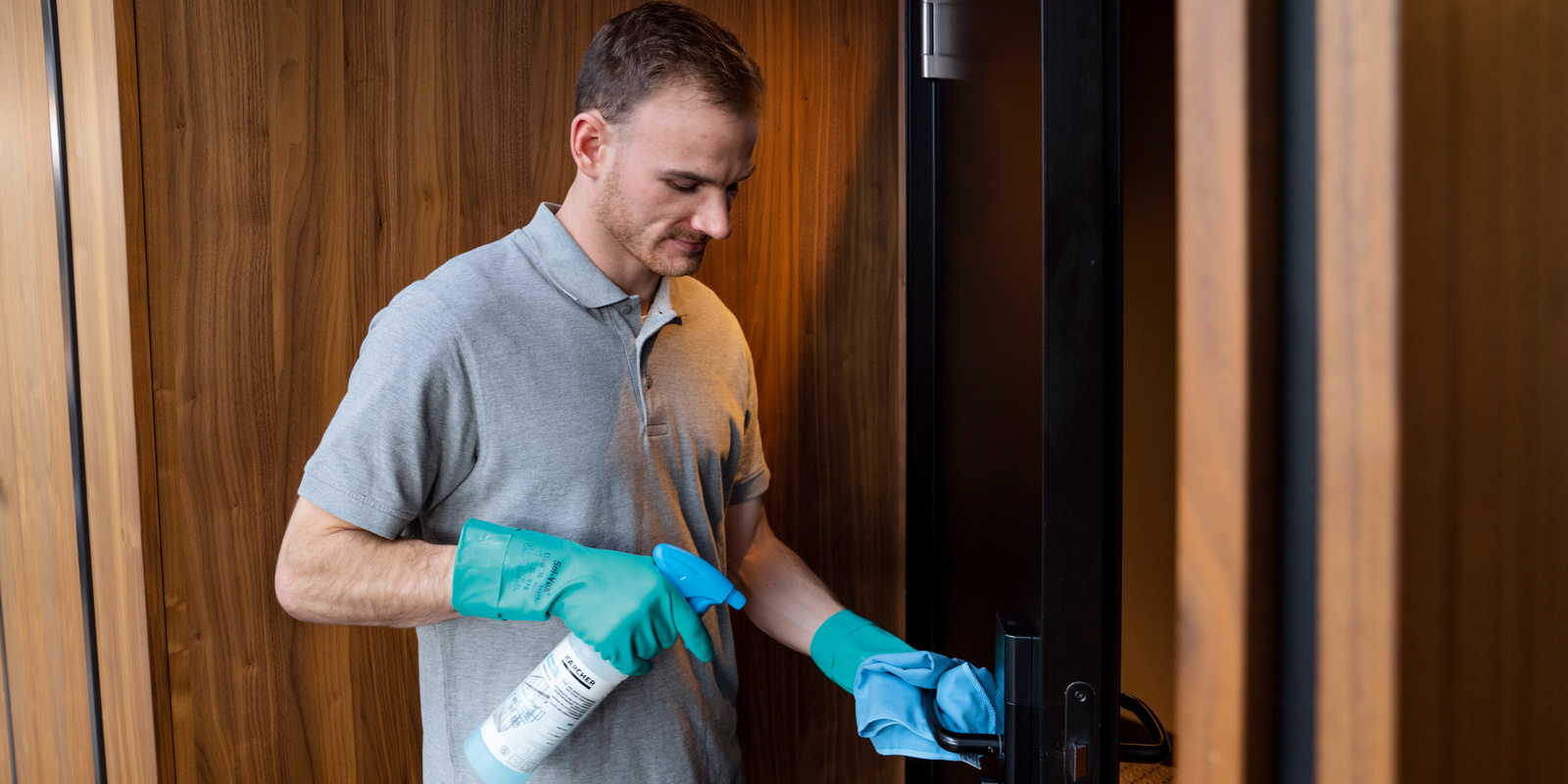
12. Hotel room disinfection
If mandatory or necessary, the next step is to disinfect relevant touch points. These include door handles, knobs on cabinets, remote controls, the telephone, the bedside table, light switches, sink knobs, window handles, etc.
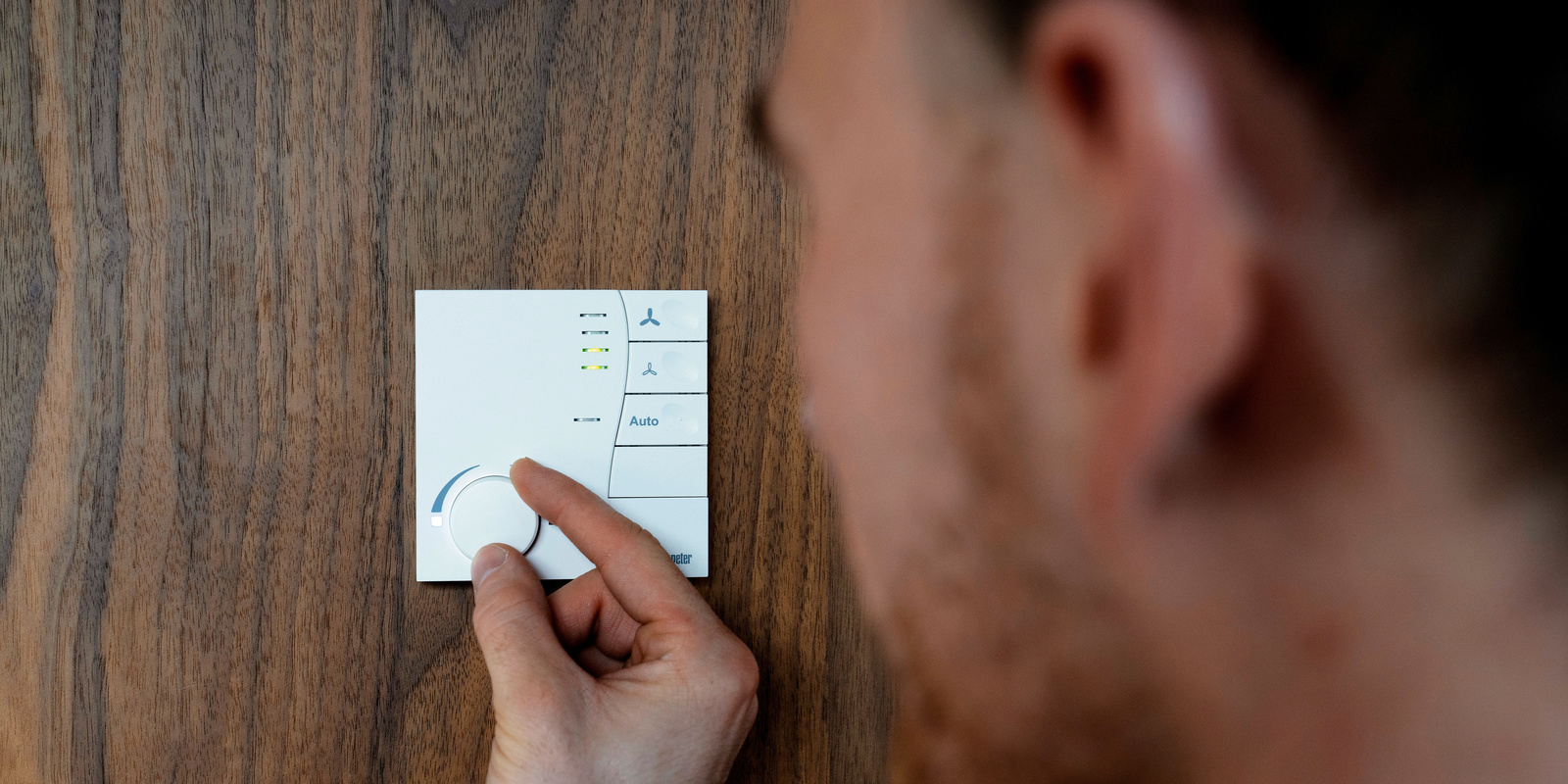
13. Final room check
After the cleaning is done there’s a final check to ensure everything has been cleaned. This ensures that the guest finds the room in perfect condition. It should also be noted here that the air conditioning should be reset. Often, a signature scent is also used in hotels: air fresheners ensure that certain scent nuances associated with cleanliness give the room the final touch.
Efficient teamwork - when two people do the cleaning
In large hotels in particular, two people often work together as a team when cleaning rooms. Two rooms can be worked on at the same time, with each person taking on specific tasks. For example, one team member takes care of cleaning the bathroom, and one tackles the room itself. The advantage of working as a team is that more substantial tasks, such as making the bed, can be done together, making them easier to tackle. This approach is especially recommended when guests check-out and new guests check-in.
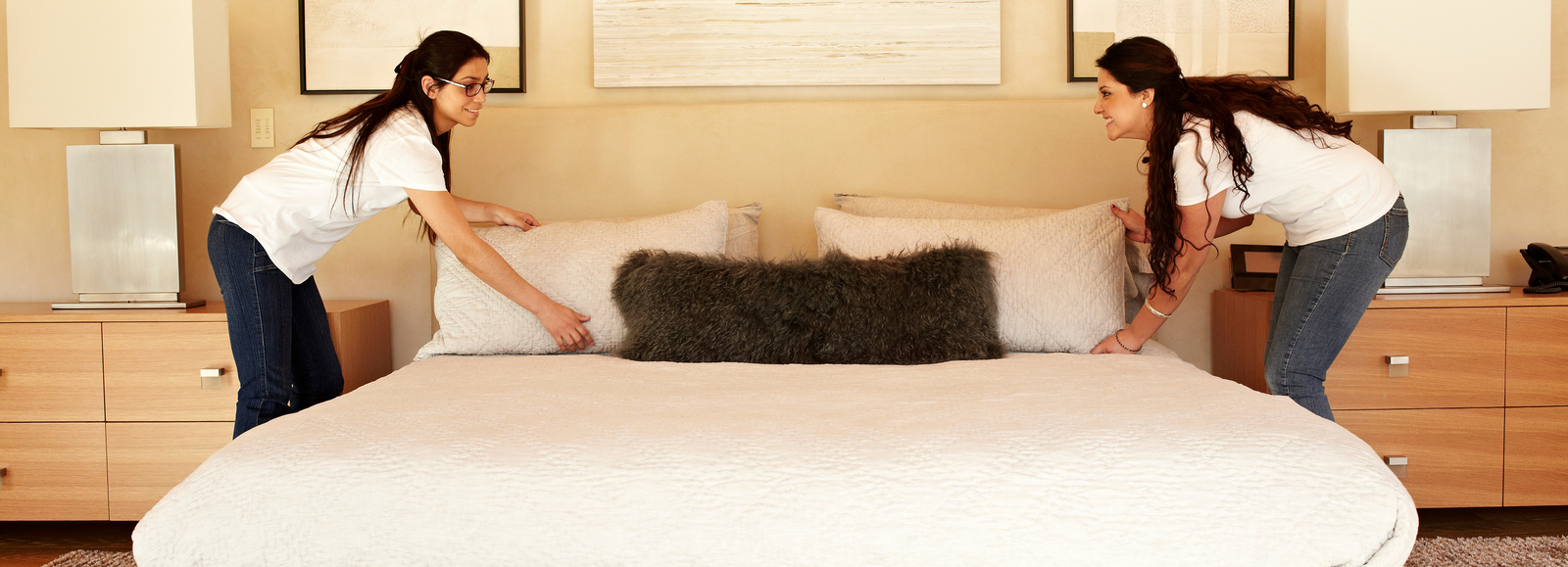
Deep cleaning of a hotel room
Deep cleaning should be performed about once a year. This comprehensive and more detailed cleaning of a hotel room helps to ensure that it retains its value and positive appearance. Deep cleaning is also unavoidable if a pest infestation is detected or if a guest is ill for example.
As a rule during deep cleaning, a hotel room is not useable for 24 hours. Because of this, it should be scheduled during the off-season or at the end of a season to minimise economic downtime. This is particularly useful if the cleaning is combined with renovation work. To be able to work as economically as possible when deep cleaning, it’s advisable not to tackle individual hotel rooms, but to combine several rooms. For example, an entire floor.
In addition to detailed window cleaning, for example, deep cleaning of the hotel room includes: deep cleaning of the floor, which varies depending on the type of flooring.



